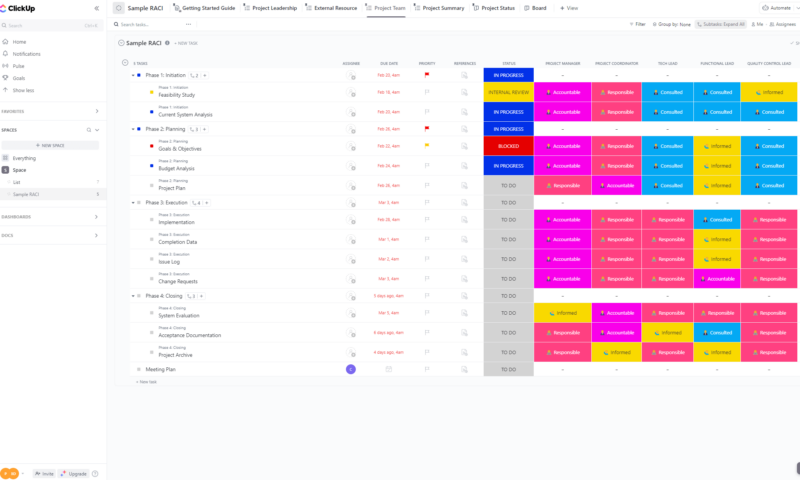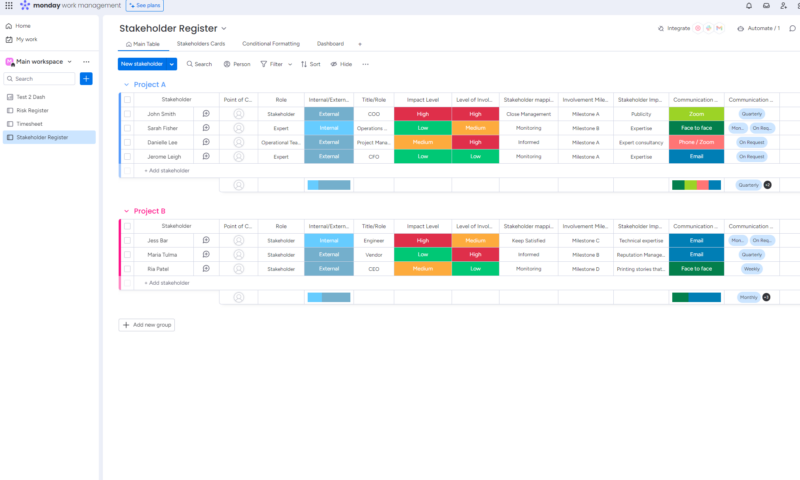Creating project charters before a project begins is one of the most important steps a project manager can take to set up for success. However, equally important is the less-talked-about stakeholder analysis process. This process can ensure team alignment and can be carried out in many of the best project management software platforms.
Proper stakeholder analysis ensures that the project manager, scrum masters and product owners understand the project stakeholders and their influence before a project begins. It may seem trivial, but failing to grasp internal and external stakeholders’ motivations, needs and wants can quickly bring a project to its knees.
In this stakeholder analysis guide, you’ll learn about the types of stakeholders you’ll interact with and the four steps in stakeholder analysis. You’ll also discover stakeholder analysis methods and why it’s vital to get to know your stakeholders. If you’re looking for a broader overview, our article on the characteristics of project management may be just what you need.
What Is a Stakeholder Analysis?
Stakeholder analysis is the process of identifying all internal and external individuals a project will involve or affect before work on the project begins. As a project manager, scrum master or product owner, you should group key stakeholders by levels of participation, interest in the project and levels of influence, and then determine how to communicate with them.
After identifying stakeholders and conducting stakeholder analysis, project managers can determine who needs to be engaged, how often communication should occur and which information should be shared. When performed correctly, the stakeholder analysis process can increase buy-in and support throughout the project life cycle.
Stakeholder Analysis Theory
When conducting research into stakeholder analysis, you’ll likely run into the stakeholder analysis theory. This theory, which first appeared in 1984, states that organizations should deliver value to all employees, investors, suppliers and other related parties rather than only prioritizing shareholders.
The theory has since become a major topic in business ethics. Many champion the idea that shareholder value should not be the major objective of conducting business, as maximizing it at the expense of everything else is simply not sustainable.
The Four Types of Stakeholders
The types of important stakeholders you interact with will vary based on the company’s organizational structures and the nature of the project itself. However, regardless of these factors, there are generally four types of stakeholders who will have business interests in a project. They are:
- Influencers: This group includes those who have the power to influence decisions and potentially change the direction of a project. You might encounter influencers from unions or lobby groups, or they might be individuals in your company who strongly agree or disagree with the project.
- Governance: This group of stakeholders includes company owners, senior executives, board members, regulators and auditors. They typically take great interest in how a project is being run, the processes being used and the overall quality of the project. They’re also the most likely group to offer guidance and advice during the project.
- Providers: This category includes contractors, suppliers, temporary staffing agencies and anyone else who supplies resources to the project. This group will generally be interested in the financial side of the project, health and safety, resource allocation and how they can directly impact project processes and operations.
- Users: This group comprises individuals who will make use of the products and services created during the project. They will want regular updates on project progress and may expect to take part in sprint reviews so they can inspect product iterations, provide feedback and request new features or changes.
The Four Steps of Stakeholder Analysis
Conducting an analysis of various stakeholders is a straightforward process that only requires four steps, but don’t let this fool you. A stakeholder assessment is one of the most important tasks a project manager or product owner can do outside of creating a project scope (a detailed project plan). The four steps of stakeholder analysis are:
- Identifying stakeholders: Before the project begins, project leaders should list every stakeholder with whom they may need to communicate.
- Stakeholder mapping: Stakeholders should be mapped with a power grid or modified RACI chart. They can be high power, high interest (must keep them happy); high power, low interest (keep them satisfied); low power, high interest (keep them informed); or low power, low interest (share project details sporadically).
- Engaging with stakeholder groups: Come to a consensus regarding how, when and where communication will occur with each stakeholder group.
- Understanding stakeholders: Communicate with stakeholders and ask how they feel about the project. Discuss the vision, plans and goals to gauge interest levels, and to determine who will be an ally and who may raise concerns.

What Is the Purpose of Stakeholder Analysis?
Stakeholder analysis identifies stakeholders before a project begins and helps project leaders determine each stakeholder’s impact, which can increase the likelihood of buy-in and support. Managing stakeholders can help you execute projects that meet or exceed expectations. Below, we’ll look more closely at why you should trust the process.
Benefits of Stakeholder Analysis
Whether you use Agile frameworks or traditional project management methods, taking the stakeholder analysis process seriously can set a firm foundation for success in any project management career. As you can imagine, many benefits can come from this process, including:
- Gaining support: The better you analyze stakeholders and understand their needs, the more support you will have.
- Optimized resources: By understanding what internal stakeholders and external stakeholders bring to the table, you can influence how and when resources are delivered, optimize supply chains and more.
- Better relationships: Knowing the project stakeholders and having an idea of what makes them tick can boost professional relationships, which in turn will lead to free-flowing, non-toxic work environments.
- Enhanced communication: Understanding how each stakeholder likes to be contacted can ease tensions and encourage transparent communication.
- Clear expectations: Going into a project, whether simple or complex, with everyone on the same page will make everything run more smoothly.
- Higher-quality products: Perhaps the biggest benefit to come from the stakeholder analysis process is the prospect of higher-quality deliverables. With everyone on the same page and all expectations and goals aligned, project teams know precisely what’s expected of them.
Stakeholder Identification Methods
Now that you know what the stakeholder analysis process is and the benefits of getting to know stakeholders, it’s time to look at a few popular stakeholder analysis tools and methods for identifying who the power and bit-part players in your project are. The four most popular stakeholder analysis methods are:
- Power grid: This is used to analyze stakeholders via a quadrant grid that determines each individual’s power within the organization and level of interest in the project. The X and Y axes in the power grid represent interest and power, respectively.
- Power-predictability matrix: Similar to the power grid, the power-predictability matrix uses a quadrant to determine how much power a stakeholder has and how predictable they are. The X and Y axes in the power-predictability matrix represent predictability and power, respectively.
- Salience model: The salience model uses Venn diagrams to help determine the power, legitimacy and urgency of all project stakeholders.
- Stakeholder knowledge base chart: This method uses a quadrant grid to identify stakeholders. It helps project leaders determine stakeholders’ awareness levels and whether they approve of or disagree with the project. The quadrant grid has X and Y axes that denote stakeholder attitude and knowledge, respectively.
Stakeholder Analysis Template
Creating and maintaining tools that can help you conduct stakeholder analysis can be challenging, especially if you make them yourself. Fortunately, plenty of the best free project management software solutions and many paid options offer templates you can use as-is or customize to your liking.

You should use templates whenever possible, as they will help you quickly conduct a stakeholder analysis meeting. Many out-of-the-box templates can track preferred engagement methods and roles, whether stakeholders are internal or external, and their levels of impact and involvement.
This monday.com template and this ClickUp template do all of that and more. To find out more about what monday.com can do, check out our monday.com review. Alternatively, learn more about ClickUp in our ClickUp review.
How Do You Conduct a Stakeholder Analysis?
Every stakeholder analysis process will look different based on the project you’re working on, the project management methodology you use and the organizational structure in place. However, as a general rule, the process will look similar to the stakeholder analysis example below.
- Identify the Project Stakeholders
The project leadership team should meet to identify every stakeholder (internal and external) who will impact or influence the project in any way, shape or form. Everyone from suppliers to executives, from providers to end users, and from marketers to finance managers should be listed. - Group Stakeholders Together
After brainstorming and identifying every stakeholder, it’s time to categorize each individual stakeholder based on their influence, how involved they will be, their level of interest and the power they hold via one of the analysis methods discussed earlier. - Determine Communication Methods to Win Stakeholder Favor
After prioritizing stakeholders, the next step is to determine how to gain support from each individual. Brainstorm with your team, using mind maps to note what motivates each stakeholder and how the project can be aligned to match their priorities. - Develop a Communication Plan
Once you have figured out what motivates each stakeholder, it’s time to create a communication plan. Discover how each stakeholder likes to communicate and devise a plan that will allow stakeholders to attend project review meetings so they can share feedback and request new features.
After you have developed a RACI chart or used a template that allows you to note down all of your findings, it’s time to start working on the project charter and hold a kickoff meeting to get all the key project players on the same page and on your side.
Final Thoughts
No matter which project management methodology you use, you should conduct a stakeholder analysis before every new project. You’ll get a good idea of who you’ll be interacting with, whether you’ll face any opposition and who will be an ally from the start. Determining this upfront will help you plan better and lead to a more smoothly running project.
What’s your favorite project management methodology, and what does the process of analyzing stakeholders look like to you? Have you found that the process makes influencing and winning over stakeholders easier, or do you fear the stakeholder management process due to potential pushback? Let us know in the comment section and, as always, thanks for reading.
FAQ: Stakeholder Identification
-
The four steps of stakeholder analysis are identifying stakeholders, stakeholder mapping, engaging with stakeholders and understanding stakeholders.
-
The four types of stakeholders are influencers, governance, providers and users.
-
The stakeholder analysis theory states that employees, project investors and suppliers should be valued just as much as shareholders.
{“@context”:”https:\/\/schema.org”,”@type”:”FAQPage”,”mainEntity”:[{“@type”:”Question”,”name”:”What Are the Four Steps of Stakeholder Analysis?”,”acceptedAnswer”:{“@type”:”Answer”,”text”:”
The four steps of stakeholder analysis are identifying stakeholders, stakeholder mapping, engaging with stakeholders and understanding stakeholders.\n”}},{“@type”:”Question”,”name”:”What Are the Four Types of Stakeholders?”,”acceptedAnswer”:{“@type”:”Answer”,”text”:”
The four types of stakeholders are influencers, governance, providers and users.\n”}},{“@type”:”Question”,”name”:”What Is the Stakeholder Analysis Theory?”,”acceptedAnswer”:{“@type”:”Answer”,”text”:”
The stakeholder analysis theory states that employees, project investors and suppliers should be valued just as much as shareholders.\n”}}]}
Sources:
The post What Is a Stakeholder Analysis? Importance, Benefits and Steps in 2024 appeared first on Cloudwards.

